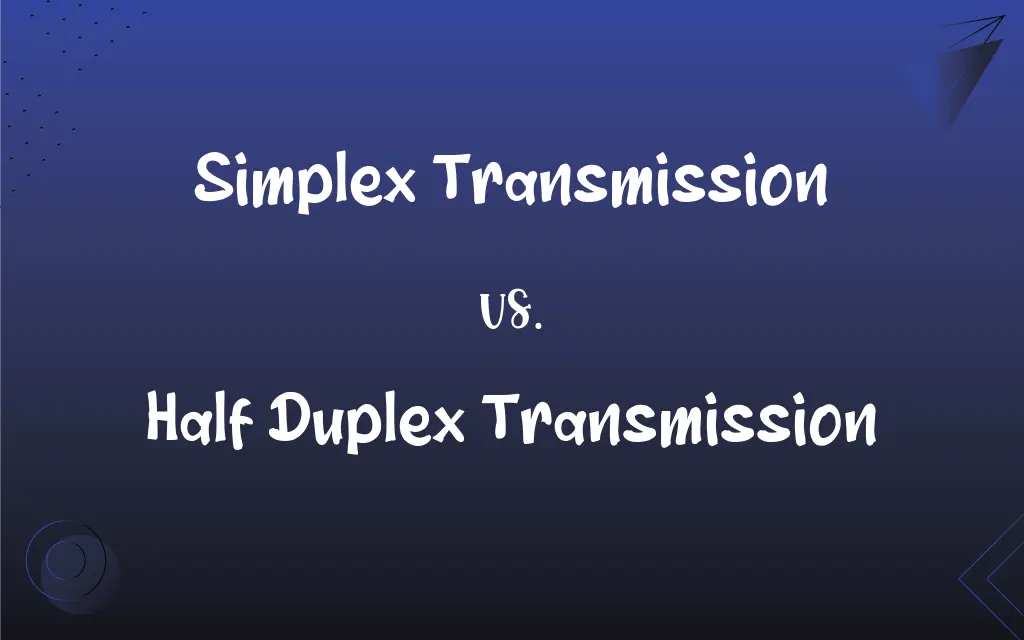Simplex Transmission vs. Half Duplex Transmission: What's the Difference?
Edited by Janet White || By Harlon Moss || Updated on October 9, 2023
Simplex transmission allows communication in one direction only, while half-duplex transmission enables two-way communication but not simultaneously.

Key Differences
In the context of data transmission, simplex transmission and half-duplex transmission represent two distinct methods of communication between devices. Simplex transmission is unidirectional, meaning the data moves from a transmitter to a receiver, never reversing direction. In contrast, half-duplex transmission enables bidirectional communication, though data transmission and reception occur at different times, not concurrently, showcasing differences in their communication capabilities.
When considering applications, simplex transmission and half-duplex transmission are best suited for different types of communication systems. Simplex transmission is optimal in scenarios where only one-way communication is necessary, such as radio broadcasts. On the other hand, half-duplex transmission can be advantageous in situations that require back-and-forth communication but where simultaneous transmission is not critical, demonstrating their varying applicabilities based on communication needs.
Examining network traffic efficiency, simplex transmission and half-duplex transmission reveal distinct characteristics. Simplex transmission might be perceived as less efficient as it does not allow return communication, which might be needed for acknowledgments or error handling. In comparison, half-duplex transmission does permit two-way communication, although the channel must be clear before a return message can be sent, implying variances in their network traffic management and efficiency.
In a technological perspective, the choice between simplex transmission and half-duplex transmission can significantly impact the design and functionality of communication systems. Simplex transmission systems tend to be simpler, with no need for mechanisms to manage bidirectional communication. Conversely, half-duplex transmission necessitates a design that can handle switching between sending and receiving, highlighting disparities in their technological and design requirements.
In a practical sense, simplex transmission and half-duplex transmission cater to different communication requirements within varied scenarios and industries. While simplex transmission finds a place where messages do not require a reply, such as television broadcasts, half-duplex transmission may be applied in scenarios where communication can take place in turns, like traditional walkie-talkies, elucidating their application in real-world communication instances.
ADVERTISEMENT
Comparison Chart
Directionality
One-way communication
Two-way, not simultaneous
Complexity
Generally simpler
Requires switching mechanism
Application Examples
Radio broadcasts
Walkie-talkies
Communication Efficiency
No return communication
Can send and receive (not at once)
System Design
No need for bidirectional handling
Must manage bidirectional flow
ADVERTISEMENT
Simplex Transmission and Half Duplex Transmission Definitions
Simplex Transmission
Simplex transmission allows data flow in a single direction only.
Traditional TV broadcasts utilize simplex transmission to deliver signals to your home.
Half Duplex Transmission
Half-duplex transmission involves a mechanism to switch between sending and receiving modes.
The push-to-talk feature exemplifies half-duplex transmission by distinctly separating talking and listening phases.
Simplex Transmission
Simplex transmission is unidirectional, meaning it does not allow for feedback or reply.
The radio station employs simplex transmission, broadcasting music without receiving direct responses from listeners.
Half Duplex Transmission
Half-duplex transmission facilitates two-way communication but not simultaneously.
Walkie-talkies use half-duplex transmission, allowing users to either talk or listen at a time.
Simplex Transmission
Simplex transmission typically involves a transmitter and a receiver without reciprocal communication.
The public announcement system uses simplex transmission to convey messages to passengers at the station.
Half Duplex Transmission
Half-duplex transmission requires a single communication channel for both transmitting and receiving.
Traditional CB radios used half-duplex transmission, employing a single channel for all communications.
Simplex Transmission
Simplex transmission can be found in various broadcasting mediums to disseminate information widely.
The lighthouse uses simplex transmission to send a light signal to ships without receiving signals in return.
Half Duplex Transmission
Half-duplex transmission is utilized where bidirectional communication is required but not concurrently.
Two-way radios in security teams utilize half-duplex transmission to coordinate while ensuring clear message delivery.
Simplex Transmission
Simplex transmission is often utilized in systems where back-and-forth communication is unnecessary.
The emergency broadcast system employs simplex transmission to send alerts to all receivers.
Half Duplex Transmission
Half-duplex transmission enables devices to take turns in sending and receiving messages.
Old telephones utilized half-duplex transmission, wherein speaking and listening did not occur at the same instant.
FAQs
Where is simplex transmission commonly used?
Simplex transmission is commonly used in broadcasting, such as radio and television.
Is simplex transmission efficient for two-way communication?
No, simplex transmission is not suitable for two-way communication as it allows one-way data transfer only.
What is simplex transmission?
Simplex transmission is a communication method allowing data transfer in one direction only.
Is a telephone conversation an example of half-duplex transmission?
Traditional telephones used half-duplex transmission, but modern phones typically use full-duplex for simultaneous talk.
Can simplex transmission be upgraded to allow feedback?
Altering simplex transmission for feedback would essentially change it to a duplex transmission type (half or full).
Can half-duplex transmission manage simultaneous communication?
No, half-duplex transmission cannot handle simultaneous two-way communication.
Is simplex transmission applicable for internet communication?
Not generally, as internet communication often requires bidirectional data transfer, which simplex transmission doesn’t support.
Can half-duplex transmission be used for broadcasting?
It is not typical, as broadcasting usually doesn't require two-way communication and thus commonly uses simplex transmission.
How does half-duplex transmission work?
Half-duplex transmission enables two-way communication but requires devices to take turns sending and receiving.
Can simplex transmission receive feedback?
No, simplex transmission does not allow for feedback or return communication.
What’s a drawback of simplex transmission in interactive systems?
A drawback is its inability to accommodate feedback or back-and-forth communication in interactive systems.
Is half-duplex transmission suitable for live, two-way interviews?
Not ideally, as half-duplex transmission might create awkward pauses since it doesn't allow simultaneous communication.
What type of channel is utilized in half-duplex transmission?
Half-duplex transmission uses a single channel for both sending and receiving but not at the same time.
Does half-duplex transmission offer more interactive communication than simplex?
Yes, half-duplex transmission offers more interactive communication by allowing devices to both send and receive data, albeit not concurrently.
Are walkie-talkies an example of half-duplex transmission?
Yes, walkie-talkies typically use half-duplex transmission, allowing alternate sending and receiving of messages.
How does half-duplex transmission affect network traffic?
Half-duplex can create delays in network traffic due to its need to switch between sending and receiving.
Can devices using simplex transmission reply to a message?
No, devices utilizing simplex transmission cannot send replies as they can only send or receive messages, not both.
Can simplex transmission handle a busy channel?
Simplex transmission doesn’t manage channel busyness as it does not accommodate return messages.
Does simplex transmission require a complicated setup?
No, simplex transmission systems are generally simpler as they do not require mechanisms for two-way communication.
What kind of mechanism does half-duplex transmission require?
Half-duplex transmission requires a mechanism to switch between transmitting and receiving modes.
About Author
Written by
Harlon MossHarlon is a seasoned quality moderator and accomplished content writer for Difference Wiki. An alumnus of the prestigious University of California, he earned his degree in Computer Science. Leveraging his academic background, Harlon brings a meticulous and informed perspective to his work, ensuring content accuracy and excellence.
Edited by
Janet WhiteJanet White has been an esteemed writer and blogger for Difference Wiki. Holding a Master's degree in Science and Medical Journalism from the prestigious Boston University, she has consistently demonstrated her expertise and passion for her field. When she's not immersed in her work, Janet relishes her time exercising, delving into a good book, and cherishing moments with friends and family.































































